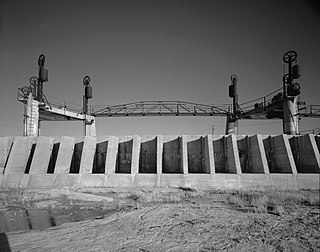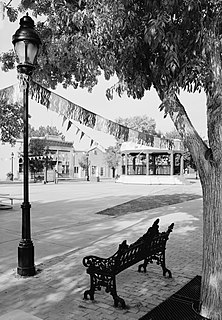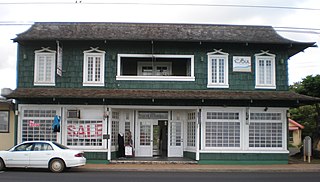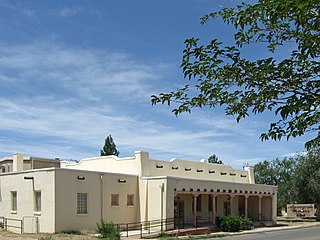
Scouting in New Mexico has had a rich and colorful history, from the 1910s to the present day, serving thousands of youth in programs that suit the environment in which they live. The state is home to the Philmont Scout Ranch.

Santa Clara Pueblo ″Singing Water Village″, also known as ″Village of Wild Roses″ is a census-designated place (CDP) in Rio Arriba County, New Mexico, United States and a federally recognized tribe of Native American Pueblo people.

Elephant Butte Dam or Elephant Butte Dike, originally Engle Dam, is a concrete gravity dam on the Rio Grande near Truth or Consequences, New Mexico. The dam impounds Elephant Butte Reservoir, which is used mainly for agriculture but also provides for recreation, hydroelectricity, and flood and sediment control. The construction of the dam has reduced the flow of the Rio Grande to a small stream for most of the year, with water being released only during the summer irrigation season or during times of exceptionally heavy snow melt.

The Palace of the Governors is an adobe structure built in the Territorial Style of Pueblo architecture on Palace Avenue in Santa Fe, New Mexico. Located within the Santa Fe Historic District along the Santa Fe Plaza between Lincoln and Washington avenues, it has served as the seat of government for New Mexico for centuries, having been established as the capitol building of Nuevo México in 1610.

The historic U.S. Route 66 ran east–west across the central part of the state of New Mexico, along the path now taken by Interstate 40 (I-40). However, until 1937, it took a longer route via Los Lunas, Albuquerque, and Santa Fe, now roughly New Mexico State Road 6 (NM 6), I-25, and US 84. Large portions of the old road parallel to I-40 have been designated NM 117, NM 118, NM 122, NM 124, NM 333, three separate loops of I-40 Business, and state-maintained frontage roads.
La Cueva is an unincorporated community on the Mora River in Mora County, New Mexico, United States, situated at the intersection of New Mexico State Roads 442 and 518.

The Barrio de Analco Historic District is a National Historic Landmark District centered at the junction of East De Vargas Street and Old Santa Fe Trail in Santa Fe, New Mexico. The seven buildings of the district represent one of the oldest clusters of what were basically working-class or lower-class residences in North America, and are in a cross-section of pre-statehood architectural styles. It includes two of the oldest colonial-era buildings in the southwest, the San Miguel Mission church (1710), and the "Oldest House", built in 1620 and now a museum. The district was declared a National Historic Landmark in 1968.

The Carlsbad Irrigation District, also known as Carlsbad Reclamation Project or Irrigation system of the Pecos Irrigation and Improvement Company, is a major early water reclamation project located near Carlsbad in southeastern New Mexico. Begun in the 1880s, it is now managed by the United States Bureau of Reclamation, and provides irrigation water to a large area around Carlsbad, diverted from the Pecos River and the Black River. The late 19th and early 20th-century elements of the project were designated a National Historic Landmark District in 1964.

Mesilla Plaza is the central plaza in the small town of Mesilla in far southern New Mexico. The plaza and a number of its surrounding buildings are a National Historic Landmark District, significant for its role in the transfers of power that brought first the original New Mexico Territory and later the Gadsden Purchase into United States control. The most notable building facing the plaza is the Basilica of San Albino, which has been on the plaza since its establishment in 1851. The plaza was declared a National Historic Landmark in 1961.

Watrous, also named La Junta, is a National Historic Landmark District near Watrous, New Mexico. It encompasses the historic junction point of the two major branches of the Santa Fe Trail, a major 19th-century frontier settlement route between St. Louis, Missouri and Santa Fe, New Mexico. La Junta, marked this junction point, as well as the first major indications of civilization before westbound travelers reached Santa Fe. The district includes a large area west of the modern community of Watrous, encompassing the confluence of the Mora and Sapello Rivers. Surviving buildings include the houses of early ranchers, as well as a stagecoach mailstop and inn. The district was designated a National Historic Landmark in 1963.

Seton Village is a National Historic Landmark District in a rural residential area south of Santa Fe in Santa Fe County, New Mexico, United States. It encompasses a residential settlement and educational facility established in 1930 by Ernest Thompson Seton (1860-1946), an educator and conservationist best known as a founder of the Boy Scouts of America. The district includes the remains of Seton's 32-room home and other residential and educational buildings constructed mostly between 1930 and 1945. It was declared a National Historic Landmark in 1965.

San Estévan del Rey Mission Church is a Spanish mission church on the Acoma Pueblo Reservation in western New Mexico. Built between 1629 and 1641, it is one of the finest extant examples of hybrid Spanish Colonial and Puebloan architectural styles. It was named for Saint Stephen I of Hungary. The church was declared a National Historic Landmark in 1970, and is listed on the National Register of Historic Places.

There are 73 properties listed on the National Register of Historic Places in Albany, New York, United States. Six are additionally designated as National Historic Landmarks (NHLs), the most of any city in the state after New York City. Another 14 are historic districts, for which 20 of the listings are also contributing properties. Two properties, both buildings, that had been listed in the past but have since been demolished have been delisted; one building that is also no longer extant remains listed.

The Seto Building at 4-1435 Kuhio Highway in Kapaʻa, Kauaʻi, was earlier known as the Quality Market and then the Big Save Building. It was built in 1929 to serve as the first general food market on the island of Kauaʻi, with the latest refrigeration methods to store a variety of fresh meat and produce. Its owner, Ah Doi Seto, had immigrated from China in 1888 to work on a sugarcane plantation, but later left the plantation to open a business in bustling Kapaʻa. The building is significant as an unusual example of modern commercial architecture with Chinese design elements, but also as a forerunner of contemporary supermarkets. It was listed on the National Register of Historic Places in 1979.

The Rosenwald Building is a historic building located in Downtown Albuquerque, New Mexico. Designed by Henry Trost of the El Paso firm of Trost & Trost and built in 1910, it was the first reinforced concrete building in the city. It is a massive three-story building with a two-story recessed entrance and simple geometric ornamentation. The building was added to the New Mexico State Register of Cultural Properties and the National Register of Historic Places in 1978.

The Alamogordo Woman's Club is a women's club based in New Mexico. It operates under the auspices of the New Mexico Federation of Women's Clubs (NMFWC). The club was created to provide Alamogordo women a way to serve their community. Of note was the Alamogordo Woman's Club's providing books to school libraries.
The Hooks-Moore Store, at the southwest corner of the junction of NM 61 and Forest Rt. 73 in Mimbres, New Mexico, was built before and during 1922. It was listed on the National Register of Historic Places in 1922.
Miles Brittelle, whose full name is William Miles Brittelle, Sr., was an American architect who practiced in New Mexico, including with John J. Ginner as part of Brittelle & Ginner.

The Narciso Valdez House, on New Mexico State Road 120 in Ocate, New Mexico, was built between 1895 and 1898. It was listed on the National Register of Historic Places in 1980.

La Cueva Historic District, in Mora County, New Mexico near Mora, New Mexico, is a historic district which was listed on the National Register of Historic Places in 1973. The listing included five contributing buildings on 47 acres (19 ha).


















